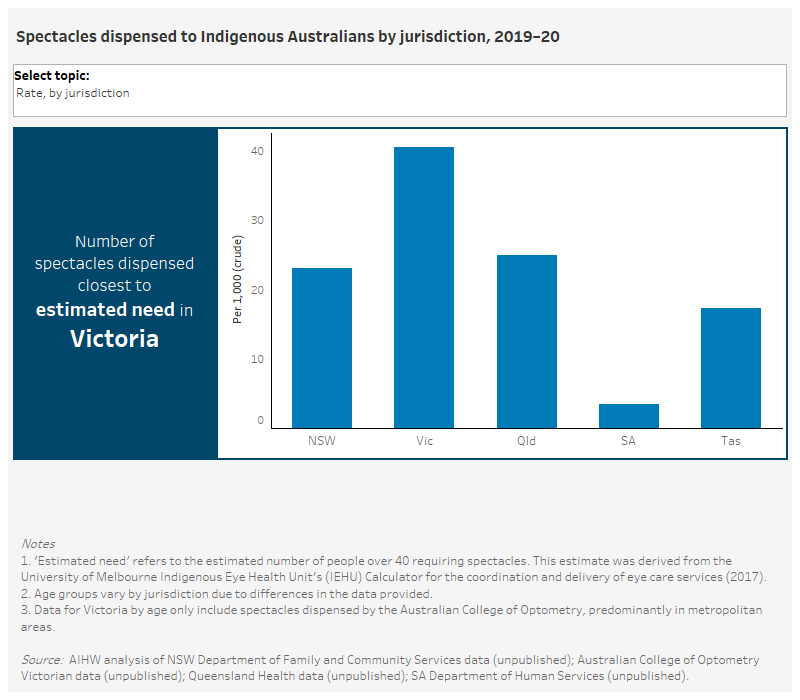Spectacles dispensed under state schemes
Measure 3.10: The number of spectacles dispensed to Indigenous people under state subsidised spectacles programs, per 1,000 population.
All jurisdictions have subsidised spectacle schemes but only 4 jurisdictions—New South Wales, Victoria, Queensland and South Australia—could provide data on Indigenous Australians for this measure. The eligibility criteria and entitlements provided by the state schemes vary across jurisdictions.
This chart presents 5 separate charts showing state spectacles schemes, by various characteristics.
Number of spectacles dispensed and need by jurisdiction, 2019-20
This stacked vertical bar chart compares the number of spectacles dispensed in 2019–20 and the number of Indigenous Australians over 40 requiring glasses in 2019-20, by jurisdiction. The chart shows that 6,443 Indigenous Australians received glasses under the New South Wales state scheme, however, it was estimated that over 17,810 Indigenous Australians over 40 required glasses each year in New South Wales. In Queensland 5,832 adults received glasses under the state scheme, however it was estimated that 14,932 Indigenous Australians over 40 required glasses each year in Queensland. In Victoria 2,490 spectacles were dispensed under the state scheme with estimated 3,923 requiring glasses. In South Australia 153 spectacles were dispensed under the state scheme with estimated 2,847 requiring glasses. In Tasmania 518 spectacles were dispensed under the state scheme with estimated 1,907 requiring glasses.
Rate per 1,000 population of spectacles dispensed by jurisdiction, 2019-20
This vertical bar chart compares the rate per 1,000 population of spectacles dispensed in 2019─20 by jurisdiction. The chart shows that Indigenous Australians received glasses under the Victorian state scheme at a rate of 40.6 per 1,000 population. In New South Wales the rate was 23.1 per 1,000 population, in Queensland it was 25 per 1,000 population, in South Australia the rate was 3.4 per 1,000 and in Tasmania it was 17.4 per 1,000.
Rate per 1,000 population of spectacles dispensed by age and sex, NSW, 2019-20
This grouped vertical bar chart compares the rate per 1,000 population of spectacles dispensed to Indigenous Australians in 2019–20, by age and by sex, in New South Wales. The chart shows that, in New South Wales in this period, in all age groups, higher rates of Indigenous females than males received glasses under the spectacles program. The rates of Indigenous clients who received glasses were highest for males and females aged 65 years and over.
Rate per 1,000 population of spectacles dispensed by age, Qld 2019-20
This vertical bar chart compares the rate per 1,000 population of spectacles dispensed to Indigenous Australians in 2019–20, by age group, in Queensland. The chart shows that the rate of Indigenous clients receiving glasses under the spectacles program increased with age. The rate was highest among those aged 65 years and over (151 per 1,000) followed by those aged 50–64 years (68 per 1,000).
Rate per 1,000 population of spectacles dispensed by age, Vic 2019-20
This vertical bar chart shows the rate per 1,000 of spectacles dispensed to Indigenous Australians in Victoria in 2019─20, by age group. The chart shows that the rate of Indigenous clients receiving glasses under the spectacles program increased with age. The rate was highest among those aged 61 years and over (45 per 1,000) followed by those aged 51–60 years (37 per 1,000).

- In 2019–20, there were around 6,443 spectacles provided to Indigenous Australians in the New South Wales scheme (23 per 1,000), 5,832 provided under the Queensland scheme (25 per 1,000), 2,490 provided under the Victorian scheme (41 per 1,000), 518 provided under the Tasmanian scheme (17 per 1,000) and 153 provided under the South Australian scheme (3 per 1,000).
- Comparison of the number of spectacles dispensed with the estimated need for those aged over 40 showed that Victoria was closest to meeting the estimated number of glasses needed for Indigenous people aged over 40 (2,490 dispensed compared with 3,923 needed).
- In the other jurisdictions the estimated number needed was considerably greater than the number dispensed — 17,810 needed compared with 6,443 dispensed in New South Wales; 14,932 needed compared with 5,832 dispensed in Queensland; 1,907 needed compared with 518 dispensed in Tasmania; and 2,847 needed compared with 153 dispensed in South Australia.


